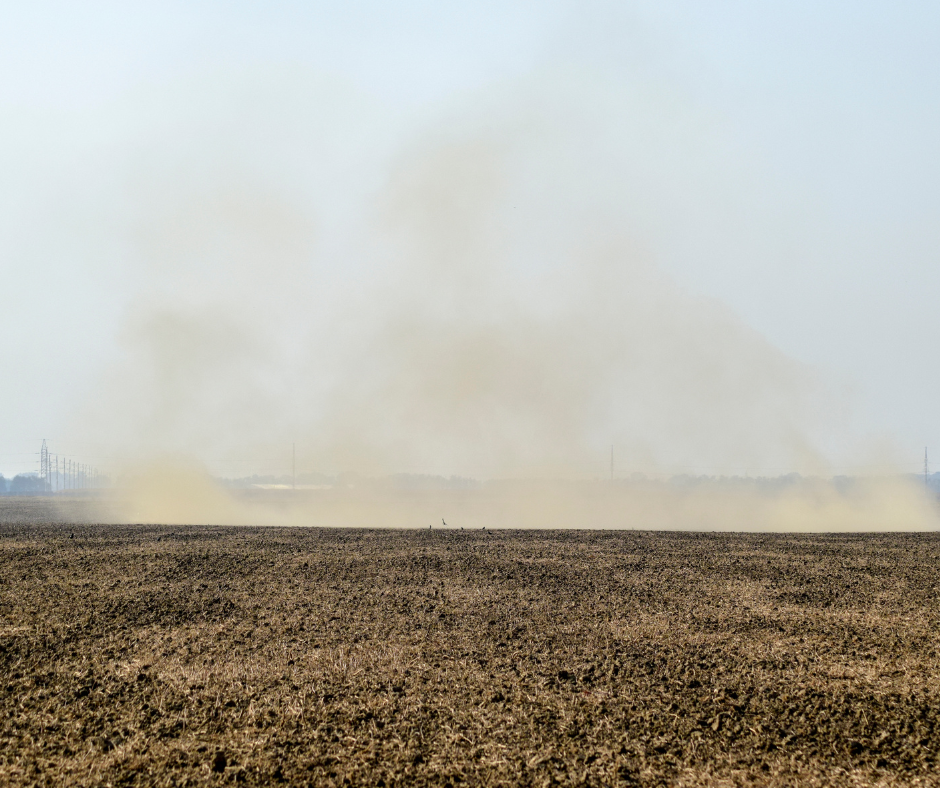Reducing Dust Storms (Wind Erosion)
On May 1st, near Springfield Illinois on Interstate 55; about 90 cars, trucks, and semi’s collided killing 7 people and hospitalizing 37 due to a dust storm. Dust storm fatalities are hard to track, but the American Meteorology Society reports about 272 fatalities occurred (27 per year) between 2007 and 2017. Dry soil conditions due to a drought, land disturbance due to freshly tilled soil from planting, and high gusting winds are the root cause (or lack of roots) blamed for this accident which occurred over a 30-mile stretch.
Dust storms occur when fast moving winds pick up soil (dirt) and debris, launching it airborne, creating conditions where visibility is greatly reduced and even breathing can be difficult. If the storms persist, this dust can travel for thousands of miles before being deposited in another location. This loss of topsoil is not only hazardous to those who experience it, the consequences can last decades or centuries in reduced soil productivity.
Dust storms have several things in common. First it takes dry soil usually from a prolonged drought. In Illinois, the soil was dry down to 8 inches. Second, it requires high winds which where 35 to 45 mph. Third, land disturbance or in this case: tilled fields freshly planted that were bare of crop residue which allowed the soil to be picked up and moved large distances. Dust storms or wind erosion occurs around the country but especially in dry areas like the Southwest. Recently, it’s becoming more common everywhere, even east of the Mississippi River. The University of Minnesota offers several trips for reducing wind erosion. A key component is keeping soil covered and finding ways to reduce the wind speed to prevent wind from removing topsoil.
First, reduce the number of tillage passes and the depth and intensity of tillage. Crop residue left on the soil surface protects soil from blowing away. As little as 30% crop residue on the soil surface can greatly reduce blowing soil. The higher the amount of crop residue left on the soil surface, less dry soil occurs, and less soil in the form of dust is removed. Crop residues allows soil to retain their moisture so it is less mobile.
Second, add a cover crop after the normal grain crop. The roots protect the soil from wind and water erosion through the fall, winter, and spring and the tops reduce wind speed. Live roots anchor loose soil turning it into soil aggregates which are larger clumps of soil not easily moved by wind or water.
Third, leave residue standing in the fall rather than flattening it or tilling it under. Raising the cutter bar up allows crop residue to slows wind speed down, reducing wind and water erosion. If chopping residue, consider leaving alternating rows or strips of chopped and un-chopped stalks. The uneven crop residue height reduces wind speed, allowing most soil particles to settle out before they come airborne.
Fourth, vegetative buffer strips can be planted in highly vulnerable areas to trap sediment and slows down wind speed. Hill tops and end rows, especially near busy highways can be protected by using vegetative buffers. Even better, plant the whole field to a cover crop, but if money is tight or cover crop planting time is short in the fall, at least plant the most wind-blown and highly susceptible areas of the field.
Fifth, windbreaks and shelterbelts (rows of trees and shrubs) are extremely effective at slowing down gusting winds. There are government payments to assist with establishment costs and rental payments for these conservation practices. Windbreaks and shelterbelts make good habitat for wildlife. Landowners can also increase beneficial insects by planting some pollinator species in these areas.
Agricultural lawsuits are almost certain to occur. A common farmer question is: What is my farm liability if a dust storm occurs? Typically, lawsuits over dust would be considered a nuisance lawsuit. Blowing dust causes a nuisance to another’s property or their enjoyment of that property. However, it could also be considered in a negligence lawsuit. In negligence lawsuits, you have a failure to do something that is ordinary, reasonable and a prudent person would not have done it. In the Illinois dust storm case, is spring planting ordinary, reasonable or prudent? Probably, so that will be difficult to prove. Also, how much dust came from each field. Hard to prove. However, if I were farming along a busy highway, and people start dying from soil blowing off my field, I might not morally be very happy with myself if I could have done something to prevent it. Something to think about.
